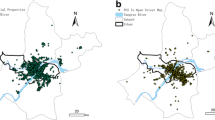Abstract
The housing market in Korea was unstable for a period of 5 years from 2003 to 2007, during which time housing prices in certain areas greatly increased in comparison to housing prices in other areas in a relatively short period. The purpose of this study is to explore temporal trends in spatial patterns of housing prices in the housing market in Seoul, Korea. We utilized apartment locations based on monthly housing prices for the sub-administration areas (dongs) of the 25 local governments (gu) in Seoul from January 2004 to December 2007, and applied spatiotemporal local G statistics. The major findings of this study are as follows. First, housing prices are highly spatially and temporally correlated in certain areas, such as Gangnam and the new towns, and housing price hotspots are sufficiently detectable in terms of spatiotemporal autocorrelation. Secondly, government housing policies affect the spatiotemporal patterns of housing prices. These results indicate that we are able to monitor spatiotemporal patterns of housing prices in a housing market, and use this approach to effectively support the decisions of housing policy makers.









Similar content being viewed by others
References
Xiao, Q., & Park, D. (2010). Seoul housing prices and the role of speculation. Empirical Economics, 38, 619–644.
Jones, R., & Yokoyama, T. (2008). Reforming housing and regional policies in Korea. OECD Economics Department, Working Paper.
Apergis, N. (2003). Housing prices and macroeconomic factors: Prospects within the European monetary union. International Real Estate Review, 6, 63–74.
Harris, J. (1989). The effect of real rates of interest on housing prices. Journal of Real Estate Finance and Economics, 2, 47–60.
Kim, K., & Park, J. (2005). Segmentation of the housing market and its determinants: Seoul and its neighbouring new towns in Korea. Australian Geographer, 36(2), 221–232.
Manchester, J. (1987). Inflation and housing demand: A new perspective. Journal of Urban Economic Literature, 21, 102–142.
Yu, H. J., & Lee, S. (2010). Government housing policies and housing market instability in Korea. Habitat International, 34, 145–153.
Kim, K. (2004). Housing and the Korean economy. Journal of Housing Economics, 13, 321–341.
Zhu, J. (1997). The effectiveness of public intervention in the property market. Urban Studies, 34, 627–646.
Hong, S., Kim, G., & Lee, K. (2007). Analysis of the effects of real estate policy on housing prices. Proceeding of the Annual Meeting of the Korea Planners Association, 10, 1225–1233.
Jung, S. (2007). The influence of the housing policy on the housing price in Seoul. Seoul, Korea: The University of Ewha, Master’s Thesis.
Kim, K., & Park, J. (2003). The spatial pattern of housing prices: Seoul and new towns. Journal of the Korean Regional Science Association, 19, 47–61.
Kim, M. (2007). The analysis that the residence and the real estate. Seoul, Korea: University of Hanyang, Ph.D. Dissertation.
Kim, W. (2005). A study on positive analysis of housing policies effect: Focusing on effect of housing price changes. Seoul, Korea: The University of Kookmin, Ph.D. Dissertation.
Kim, K., & Cho, M. (2010). Structural changes. Housing Price Dynamics and Housing Affordability in Korea, Housing Studies, 25(6), 839–856.
Henderson, J. V., & Ioannides, Y. (1983). A model of housing tenure choice. The American Economic Review (AER), 73(1), 98–113.
Sohn, H. (2008). Modeling spatial patterns of an overheated speculation area. The Korean Geographical Society, 43(1), 104–116.
Geary, R. C. (1954). The contiguity ratio and statistical mapping. Incorporated Statistician, 5, 115–145.
Getis, A., & Ord, J. K. (1992). The analysis of spatial association by use of distance statistics. Geographical Analysis, 24, 186–206.
Moran, P. (1948). The interpretation of statistical maps. Journal of Royal Statistical Society, 10, 243–251.
Anselin, L. (1995). Local indicators of spatial association-LISA. Geographical Analysis, 27, 93–115.
Ord, J. K., & Getis, A. (1995). Local spatial autocorrelation statistics: Distribution issues and an application. Geographical Analysis, 27, 286–306.
Getis, A., & Ord, J. K. (1996). Local spatial statistics: An overview. In Spatial analysis: Modelling in a GIS environment (pp. 261–277). Cambridge: GeoInformation International.
Wong, W. S. D., & Lee, J. (2005). Statistical analysis of geographic information with ArcView GIS and ArcGIS (pp. 367–393). Hoboken, NJ: Wiley.
Huanga, B., Bo, W., & Michael, B. (2010). Geographically and temporally weighted regression for modeling spatio-temporal variation in house prices. International Journal of Geographical Information Science, 24(3), 383–401.
Sun, H., Tu, Y., & Yu, S. (2005). A spatio-temporal autoregressive model for multi-unit residential market analysis. The Journal of Real Estate Finance and Economics, 31(2), 155–187.
Lee, Y. (2007). Spatiotemporal hotspot detection using G statistics. Seoul Studies, 8(3), 71–83.
Ahn, J., Kim, H., & Lee, Y. (2009). Classification of changing regions using a temporal signature of local spatial association. Environment and Planning B: Planning and Design, 36, 854–864.
Miller, H. J., & Han, J. (2001). Geographic data mining and knowledge discovery: An overview. In Geographic data mining and knowledge discovery (pp. 3–32). London: Taylor and Francis.
Yao, X. (2003). Research issues in spatio-temporal data mining. Paper presented at the University Consortium for Geographic Information Science (UCGIS) Workshop on Geospatial Visualization and Knowledge Discovery, Lansdowne, VA, http://www.ucgis.org/Visualization/whitepapers/Yao-KDVIS2003.pdf.
Fotheringham, A. S., Brunsdon, C., & Charlton, M. (2002). Geographically weighted regression. Chichester: Wiley.
Acknowledgments
This study was supported by the Climate Change Response Technology Project of the Ministry of Environment, the Republic of Korea (2014001310009).
Author information
Authors and Affiliations
Corresponding author
Rights and permissions
About this article
Cite this article
Seo, C., Sohn, H., Choi, YS. et al. Spatial process for housing prices in Seoul using spatiotemporal local G statistics. Spat. Inf. Res. 24, 2 (2016). https://doi.org/10.1007/s41324-016-0002-5
Received:
Revised:
Accepted:
Published:
DOI: https://doi.org/10.1007/s41324-016-0002-5




